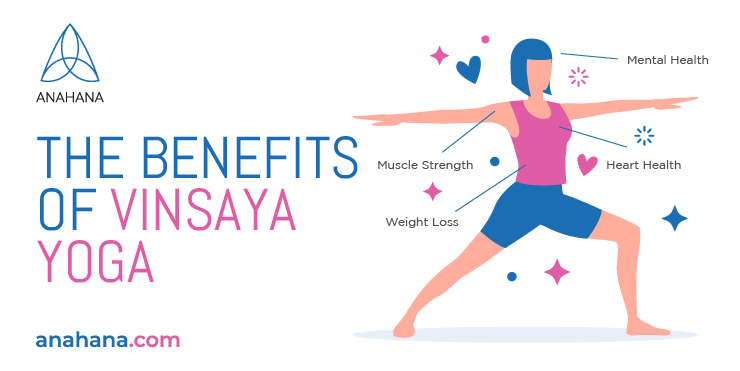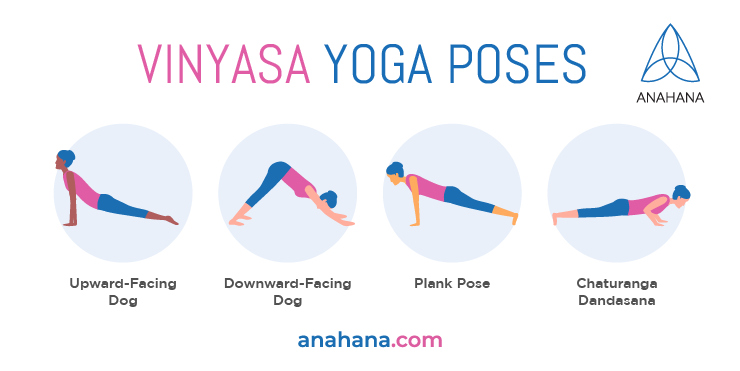
Table of Contents
The term vinyasa is derived from the Sanskrit term Nyasa, which means to place, and the prefix vi, meaning in a special way. It is a modern style of yoga that is an extension of the ashtanga yoga tradition
The history of Vinyasa Yoga
The origins of Vinyasa yoga trace back to 200 BC. However, the style is based on the teachings of Sri Krishnamacharya in the late 19th century.
His theory was that the movements between each pose are equally important as the postures themselves.
Rather than placing the body into the pose and then shifting your focus to your breath, Vinyasa yoga practice aims to continue taking deep breaths throughout the movements in a session.
Modern vinyasa flow yoga is best described as a version of Ashtanga yoga that is freestyle and does not adhere to the structure of an ashtanga Vinyasa yoga series. It is a continuous flow that links different poses, having you move from one pose to the next.
Pattabhi Jois popularized this style in the late 20th century and opened the Ashtanga Yoga Research Centre in Mysore in 1948. Officially called Mysuru since 2014, the city is known for its stunning Mysore Palace.
What to Expect in a Vinyasa Yoga Class
Many Vinyasa yoga classes will follow the structure of the Ashtanga Primary Series. This begins with Suryanamskara A and B. After this, the teacher will include their own variations of postures that flow together to form a sequence.
Many classes will also have the standing series of the ashtanga tradition and complete the practice with the traditional finishing sequence. A variation of sun salutations will also likely be included in the session. However, there is no fixed series.
Your yoga classes will always differ slightly, and the changing syllabus is a solid opportunity to explore asanas. You will likely encounter balancing postures, supine poses, forward folds, backbends, and more.
The Benefits of Vinyasa Yoga

There are a wide variety of benefits you can expect from regular vinyasa flow classes. However, here are four health improvements the fast-paced flow has to offer:
1. Weight loss: The rapid sequence of postures linked to the breathing technique makes this an excellent form of cardio. Your heart rate will increase during vinyasa classes, which is necessary for the body to burn calories.
The moderate exercise burns fat and strengthens the body by activating numerous muscles in a singular posture. Practice vinyasa yoga several days a week for best results.
2. Heart health: Vinyasa yoga is a cardiovascular workout that promotes a healthy heart. It lowers blood pressure and slows the heart rate, benefiting individuals with heart disease or high blood pressure.
In addition, yoga is linked to lower cholesterol levels and supports immune system function.
3. Strengthening and toning muscles: Vinyasa is one of the best styles of yoga for muscle toning. Many postures, including downward-facing dog, upward-facing dog, and plank position, help build upper-body strength. Standing poses are especially effective for building strength in the hamstrings, quadriceps, and abdominal muscles.
Nearly all vinyasa poses effectively build core strength.
4. Mental health: Many peer-reviewed studies suggest that vinyasa classes effectively relieve stress and calm the mind. Individuals who suffer from anxiety and depression can use Vinyasa yoga practice to improve their mental well-being through regular exercise.
One study had university students suffering from anxiety and stress complete a six-week yoga and meditation program. This program consisted of one weekly 60-minute vinyasa flow class, followed by some meditation.
The results found that their anxiety and stress scores decreased significantly, and their mindfulness increased greatly.
Vinyasa Yoga Practice
 Here is a primary flowing sequence that you can expect to perform in a Vinyasa flow class:
Here is a primary flowing sequence that you can expect to perform in a Vinyasa flow class:
Plank: Begin in a plank position, with your shoulders directly over your wrists, your head in line with your hips, your toes tucked under, and your legs straight. Try and pull your navel into your spine to maintain an engaged core with your hips lifted. Reach your heels toward the back of your mat and feel all your muscles engage.
-
Benefits: The plank has extensive benefits for the body. These benefits include strengthening the core, improving muscle definition, and increasing metabolic rate. In addition, it improves your posture and decreases back pain.
-
Risks and contraindications: Although rare, planking can cause inflammation in the cartilage that connects the breastbone to a rib. This condition is known as costochondritis.
Chaturanga: From plank position, exhale and lift your gaze to the top of your mat. Shift your weight forward so your shoulders are in front of your wrists. Maintain the plank position as you bend your elbows straight back, halfway, and hug your elbows toward your ribs. Hover in this position for just a beat.
-
Benefits: This pose strengthens and defines your arms, abdominals, wrists, and lower back. In addition, it strengthens muscles that surround the spine supporting good posture.
-
Risks and contraindications: Practitioners with an elbow, shoulder, or wrist injury should avoid this pose. In addition, if you are a woman who is menstruating or pregnant, you should not perform this pose. You can modify the pose by placing your knees on the floor.
Upward-facing dog: Rollover your toes so the tops of your feet are on the mat, keep your legs straight and engaged, straighten your arms, and feel your chest pull up through your arms. Press the top part of your feet into the ground to help keep your knees, thighs, and hips lifted above the mat. Press your shoulders down, away from your ears.
-
Benefits: This posture opens up the chest and strengthens the whole body, including the core, arms, and legs. It aligns the spine and energizes the kidneys and nervous system.
-
Risks and Contraindications: People with an injury in the back, arms, hips, or shoulders may want to avoid this pose. Pregnant women or anyone with recent surgery in their abdominal region should not perform upward-facing dog.
Downward-facing dog: Tuck your toes, shift your weight into your hands, and lift your hips up and back. Keep your arms straight, with your hands in front of your shoulders. Extend your spine by lifting the hips toward the sky and pulling your navel toward the spine. Your heels will remain slightly off the mat.
-
Benefits: This pose builds strength and tones the arms and legs. It also opens the shoulders and chest to help improve posture. Lastly, it lengthens and stretches the hamstrings and calves.
-
Contraindications: If you have a wrist or shoulder injury or are in late-term pregnancy, you may want to avoid downward-facing dog. In addition, those who have high blood pressure or are experiencing a headache should modify the position.
Frequently Asked Questions Vinyasa Yoga
How many calories does Vinyasa yoga burn?
During Vinyasa yoga, you move quickly from one posture to the next. The fast-paced style increases the heart rate, making it one of the most efficient yoga styles for burning calories. Vinyasa is estimated to burn about 400 to 500 calories per hour.
You will likely burn more calories than experienced practitioners if you are new to yoga, as the poses will be more challenging for you.
Can beginners do Vinyasa yoga?
Yes, beginners can do Vinyasa yoga and are encouraged to try it. The flowing style provides practitioners with flexibility, strength, breath work, concentration, and some meditation. These qualities make it an excellent start for new yogis.
Does Vinyasa yoga count as cardio?
Yes, Vinyasa yoga does count as cardio. The fast-paced nature and physically demanding postures make it an ideal activity for a light-intensity cardiovascular workout. It is an appropriate method of regular exercise.
Can Vinyasa yoga help with weight loss?
If your goal is to lose weight, vinyasa is the best style of yoga for this. It effectively burns calories and fat. The graceful and swift transitions form a sequence linked to breathing, increasing the body's heart rate and burning calories.
Is Vinyasa yoga safe during pregnancy?
Yes, Vinyasa yoga is safe during pregnancy, with your doctor’s approval. With some modifications, you can practice Vinyasa yoga through your third trimester. If your body is used to regular exercise, it may even be recommended that you maintain practice during your pregnancy.
What is the difference between Vinyasa yoga and hatha yoga?
Vinyasa yoga and Hatha yoga are the two of the most popular styles of yoga in western society.
Vinyasa practice is a fast-paced flow that focuses on connecting the breath to movements. You can expect to continue to flow throughout the practice rather than holding postures.
In contrast, Hatha classes are practiced slowly, focusing on breathing, holding poses, and stretching. If you are new to yoga and looking for a slow-paced style and a relaxed learning environment, hatha yoga may be suitable for you. If you are looking for something more physically challenging, Vinyasa yoga is better.
References
Difference Between Hatha and Vinyasa Yoga
Yoga Health Benefits: Flexibility, Strength, Posture, and More
Downward-Facing Dog: How to Practice Adho Mukha Svanasana
Tips for Adapting Your Vinyasa Practice During Pregnancy
What is Vinyasa Yoga? History, Elements, Characteristics | Arhanta Blog
How to do Vinyasa Flow | ClassPass
How yoga may enhance heart health
Consciousness in Motion: Vinyasa
Upward Facing Dog - Urdhva Mukha Svanasana
Why Vinyasa Yoga Is Effective For Weight Loss
How to Do Chaturanga in Yoga – EverydayYoga.com
Disclaimer
The contents of this article are provided for informational purposes only and are not intended to substitute for professional medical advice, diagnosis, or treatment. It is always recommended to consult with a qualified healthcare provider before making any health-related changes or if you have any questions or concerns about your health. Anahana is not liable for any errors, omissions, or consequences that may occur from using the information provided.

By: Clint Johnson
Clint is the driving force and founder of Anahana. Clint teaches Yoga, Pilates, mindful breathing, and meditation, catering to a global community of students and teachers.
